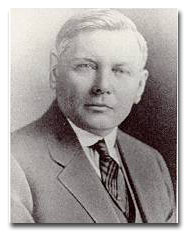GREAT CITIZENS - GOVERNOR ROSS SHAW STERLING
 Governor Ross Shaw Sterling was a pioneer oil man and the founder of a company, which was a forerunner of one of today's huge energy corporations.
Governor Ross Shaw Sterling was a pioneer oil man and the founder of a company, which was a forerunner of one of today's huge energy corporations.
Sterling was born February 11, 1875 on a small farm near Anahuac, Texas to Mary Jane (Bryan) and Benjamin Franklin Sterling, a captain in the Confederate Army. He attended public school in Anahuac and on October 10, 1898, at the age of 23, married Maud Abbie Gage. Sterling began his career as a farmer and captain of a small schooner before entering the oil industry in 1903. The first of his successes came when he hit a gushers at Sour Lake. By 1910 he had other wells and, with Walter w. Fondren, Sr., organized the old Humble Oil Company. It in turn became the parent company of the Humble Oil Corporation and in 1973, the Exxon Corporation.
Sterling served as president of the Humble Company until he sold his interests in 1925. The same year, he brought the Houston Post, merging it with the Houston Dispatch when he acquired the latter newspaper in 1926. In 1925, Sterling also became involved in real estate development in Houston and its vicinity. Among his projects were the residental Rossmoyne addition in Houston, where he built the Sterling Mansion, and the 22-story Post-Dispatch Building. Sterling entered the political arena as well when Governor Dan Moody (1929-1927) appointed him chairman of the Texas Highway Commission, which was only sporadically effective since its formation in 1917. Sterling, however, established a consistent highway program.
On January 20, 1931, Sterling was sworn in as governor of Texas after defeating the former governor (1925-1927) Miriam A. "Ma" Ferguson in the first and second Democratic primaries. His administration lasted only two years. On January 17, 1933, Ma Ferguson returned for her second term in the governor's mansion in Austin. A major problem arose during Sterling's term: unrestricted production in the huge new East Texas field drove prices down causing a depression in the oil industry. To reduce production, Governor Sterling declared a drilling curfew in four East Texas counties and ordered the National Guard to enforce it. While the Texas courts declared his move unconstitutional, he succeeded in assigning the Texas Railroad Commission its first regulatory authority over oil field drilling.
After Ma Ferguson defeated Sterling in his bid for a second term, Sterling returned to the oil business in Houston. He formed another oil company, the Sterling Oil and Refining Company, and served as its president from 1933 until he retired in 1946. A member of the Houston Port Commission from its inception, Sterling was also an original member of the board of trustees of the Hermann Hospital Estate. He also made various gifts to civic causes. Among these were Sterling's bay home in La Porte, given to the Houston Optimist Club for a boy's home in memory of his son who died as a youth, and a wooded camp overlooking Galveston Bay, donated to the South Texas YMCA. Governor Sterling died in Houston at the age of 74.






